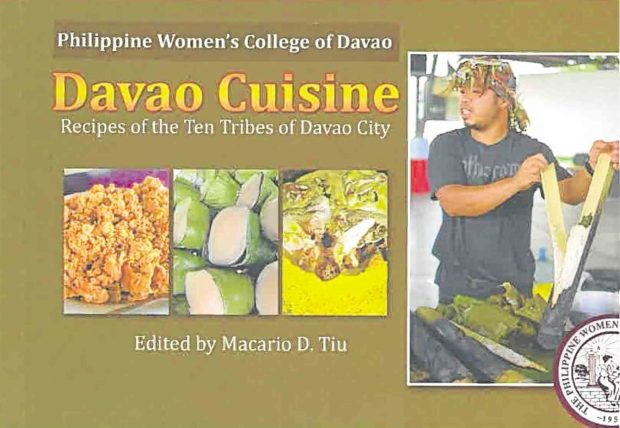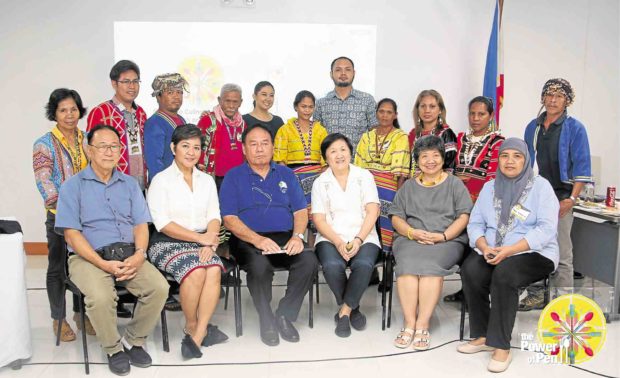
The Power of Pen is a series of lectures and workshops on culinary research and writing organized by Tetta Tirona and Stram Events. This year, the series was held in Mindanao, at Ateneo de Davao.
Two speakers were from Davao—Lolita Lacuesta and Macario Tiu.
Lacuesta, winner of the Doreen Gamboa Fernandez Food Writing Award, is the editor of “The Davao We Know” (Anvil Publishing, 2011), a compilation of personal stories by noted writers who are from, or are based, in Davao.
Her talk was on how to plan and look for writers to tell the story of a hometown or home province.
Her own story is about growing up as a Mansaka, an indigenous cultural community in the province. She wrote that at that time, they were called “nativo,” and that today’s term, lumad, started to be used only in the ’70s or ’80s.
Her food story is about “liurot” cooked in bamboo. The mixture within is “chopped meat of wild pig or deer, some tomatoes, and an aromatic herb similar to the shallot that the Mansakas call ‘ganda,’ also chopped.
Other ingredients are salt, fresh ‘katumbal’ or small chili pepper, and a little water.”
The bamboo is charred and when the food inside is deemed cooked, the bamboo is split open (expertly done so as not to scatter the food or even the sauce).
Tiu, a scholar and professor, talked about his work documenting the recipes of the 10 tribes of Davao City that was published in the book, “Davao Cuisine.”
There are five lumad groups and five Moro groups, Tiu said.
Looking for cooks to do the food involved going through deputy mayors who handle the interest of the lumad and the Moros. Sometimes they worked through friends who know the cooks.
There were representatives of the groups who attended the lectures, all wearing their native attire. One of the cooks in the book, Dawan Mukarram, a Tausug, brought native cakes— “pan-pan monggo,” “kitot,” which is like bibingkang malagkit, “isikalang,” made of sticky rice, and the cone-shaped “pasung.”
Other lecturers were Datu Shariff Pendatun III, who talked about researching on the cuisine of Muslim Mindanao, and Margaux Salcedo on feature writing and restaurant reviewing. I talked about building a food library and the importance of research.
For the workshops, lumad and Moro guests were asked to write recipes, while the rest had to write a short essay on their home food.

Cooking vessel
Like the Mansaka, the Bagobo and Obu Manuvu use bamboo as their cooking vessel.
For the Bagobo, bamboo is used to cook rice, but a “carajay” (wok) is used to cook the “sinana,” which is dried fish with coconut milk flavored with salt, vetsin and “kaningag” (cinnamon).
The Obu Manuvu use the bamboo to cook “linunot sa kasili.” They identified kasili as catfish instead of eel, which is how it is called in other places.
The catfish meat is chopped evenly, then placed inside the bamboo container. Added are onions, scallion leaves, lemon grass and salt.
The top of the bamboo opening is stuffed with banana leaf, then the bamboo is placed on open fire. The dish is cooked after 30 minutes. The bamboo is removed from the fire and split.
The winners of the essay-writing contest were quite interesting reads, and the quality suggested that they were experienced writers.
Verna Luga wrote about her grandmother’s paksiw with gabi (yam) roots called “takway.” The fish she mentioned was “moro-moro,” which I researched and found in one Mindanao news story to be a “round-scad species,” of the “genus Depateris,” or simply, galunggong.
The paksiw required hanging the takway overnight in a
nito basket which should prevent the itch. The cooking would be done in an earthenware cooking pot called “kolon” lined with young mango leaves. Put in the pot are “iba” (“bilimbi” or simply kamias), “siling kulikot” (that is, labuyo, bird’s eye chili), whole pepper, hand-crushed cherry tomatoes, crushed unpeeled ginger, garlic, sliced onions.
The freshly cut moro-moro is put on top, the dried takway, flavored with a bit of patis (fish sauce) and tuba (coconut) vinegar, all placed over the kalan or wood-fired stove.
Arnold Romero used restaurant critic Mimi Sheraton’s book title for his essay, “Eating My Words.” He didn’t write about a particular recipe but instead paid tribute to the tongue, his especially, that could accept many flavors in Mindanao, whether from lumad, Moro or Christian settlers.
He ended by calling his favorite rice cake—“made with glutinous rice flour filled with ground peanuts, shredded coconut and mung bean paste —”a literal tongue-twister.
Precy Tripoli wrote about her grandmother’s adobong maskara (pork cheeks).
Hopefully those writers will join the Doreen Gamboa Fernandez Food Writing Award this year (subject: fowl).
E-mail the author at [email protected].









































